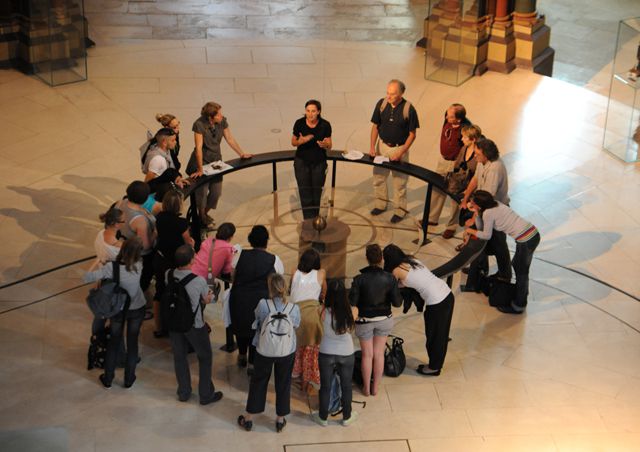Summary
Overview of the Musée des Arts et Métiers
First established in the late 18th century by the Abbot Henri Grégoire as a conservatory designed to highlight industrial innovation and development, the Musée des Arts et Métiers opened its doors as a public museum in 1802. This often-overlooked but fascinating Parisian institution will delight any visitor who is passionate about the history of science, engineering, technological development, or inventions. The museum, which has undergone intensive renovations in recent years, traces the history of important inventions and technological advancements from Antiquity to the present day. Over 80,000 objects and artifacts, along with approximately 20,000 technical drawings, make up the permanent collection, categorized into seven main thematic areas: industrial materials, construction, communication, scientific instruments, mechanics, energy, and transportation.
Notable highlights at the Arts et Métiers include the pioneering model of an airplane by the little-known but significant inventor Clément Ader, the groundbreaking calculator by Blaise Pascal, and the Lumière Brothers’ first attempts at a film camera. Housed in a stunning 11th-century church, La collégiale Saint-Martin-des-Champs, the museum also features the famed “Foucault’s Pendulum,” which has earned special recognition since the publication of Italian novelist Umberto Eco’s named novel. Therefore, make sure to visit this under-appreciated gem as a stopover to or from attractions in the center of the city; it is conveniently located and highly recommended.
Location and Contact Information:
The museum is located in the central 3rd arrondissement (district) of Paris, near significant attractions like the Centre Georges Pompidou and the Marais district.
Address:
60 Rue Reaumur
Metro: Arts et Métiers or Réaumur-Sébastopol
Tel: +33 (0)1 53 01 82 00
Visit the official website (only some information is available in English)
Opening Hours and Tickets:
The museum is open from Tuesday to Sunday, 10:00 am to 6:00 pm (extended until 9:30 pm on Thursday evenings). Closed on Mondays. The museum is open on most French bank holidays, excluding May 1st and December 25th (Christmas Day).
Tickets: See here for current information and admission prices for the museum.
The Paris Museum Pass includes admission to this museum.
Sights and Attractions Nearby:
- Centre Georges Pompidou
- The Marais Neighborhood
- Canal Saint-Martin District
- Museum Carnavalet (Museum of Paris History)
Highlights of the Permanent Collection:
The permanent collection at the Musée des Arts et Métiers is divided into seven primary areas. Each section guides you through a chronological exploration of how various technology fields evolved over centuries of innovation and trial and error.
Scientific Instruments
In this section, visitors will discover the history of scientific instruments, from pre-1750 to the present. Artifacts such as the abacus, sun-dial, early microscope, and rudimentary multiplication machines showcase the evolution of instruments that today have achieved remarkable sophistication and precision.
Materials
This section focuses on the development of industrial materials and machinery, ranging from glass and silk to textiles, iron, and steel. The rise of hydraulics and steam was a transformative moment in industrial manufacturing, leading to an escalation in commerce and the exchange of goods during the Industrial Revolution. The advent of new materials, such as plastic and aluminum, further propelled the creation of increasingly sophisticated manufacturing techniques and choices.
Construction
This section caters to architecture enthusiasts, detailing how building techniques evolved over centuries. Mechanization forever changed construction during the Industrial Revolution, resulting in not only quicker construction processes but also the introduction of new materials and grand, futuristic structures.
Communication
This intriguing section highlights the development of communication methods, including the telephone, telegraph, and radio. Visitors will begin their exploration with a close examination of one of the earliest printing presses, dating back to the 15th century.
Energy
This section offers an insightful look into the evolution of energy sources and technologies, covering everything from hydraulic windmills to steam, electricity, and nuclear energy.
Mechanics
Take a detailed look at the advancement of machinery in this section, observing how machines initially served a limited range of activities and industries before becoming integral to nearly all human endeavors from the 19th century onward, when mechanization flourished.
Transportation
One of the most popular sections of the museum, it showcases models of some of the earliest airplanes, vintage automobiles, wheels, train cars, and other artifacts reflecting the remarkable development of transportation methods through the centuries.
Temporary Exhibitions:
Temporary exhibitions at the museum usually spotlight a specific area or historical period of technological development, featuring artifacts from the museum’s permanent collection or loaned objects from other museums. Recent exhibitions included explorations of robotics history and the invention of radio. See this page for more information.
Like This?
If you have children, consider visiting the ultramodern Cité des Sciences et de l’Industrie, a contemporary science and industry museum located in the city’s far northeast.





